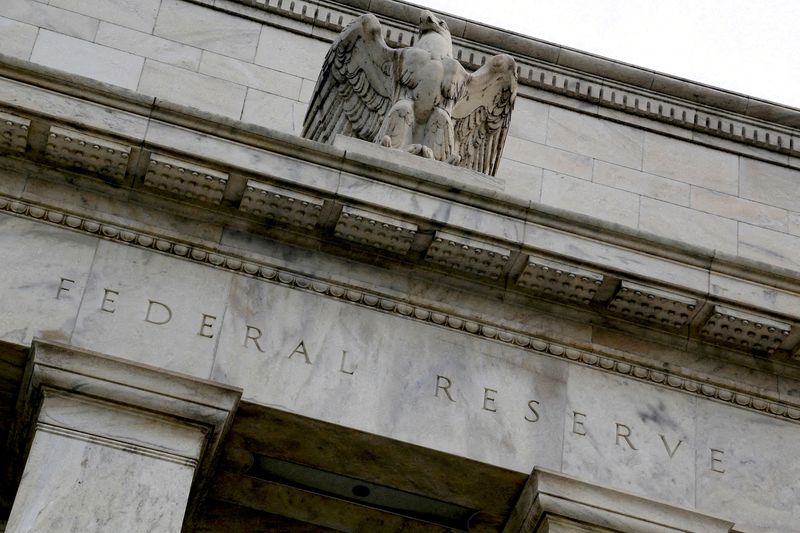By Jamie McGeever
ORLANDO, Florida (Reuters) -Engineering a soft landing is hard. But if you zoom out from the strictest definition of the term, the U.S. Federal Reserve has managed it more often than is generally believed.
Admittedly, by the textbook definition of raising interest rates to cool an overheating economy or inflation without triggering a recession, the Fed has only achieved that once in its history.
That was in the mid-1990s, when the U.S. economy avoided recession after the Alan Greenspan Fed doubled interest rates to 6% between February 1994 and February 1995.
The latest U.S. inflation and job market data this week sparked a tangible burst of optimism that the Fed, under the stewardship of Jerome Powell, might emulate that rare feat.
To be fair to the Fed, it probably is more art than science, with luck playing a bigger part than skill. What Milton Friedman called the "long and variable lags" between monetary policy decisions and their effects on the economy can be anywhere from six months to two years.
That's a big window.
In a paper earlier this year, former Fed Vice Chair Alan Blinder - who was in situ during that fabled 1994-95 soft landing - said that it is "difficult, maybe impossible" to predict the timing of policy changes on the real economy.
Blinder posits that the soft landing parameters of avoiding recession completely are too narrow. He argues that if GDP declines by less than 1% or there is no recession determined by the National Bureau of Economic Research for at least a year after a Fed tightening cycle, that is a "softish" landing.
By this definition, Blinder reckons that five of the 11 Fed tightening cycles since 1965 were followed by soft landings to varying degrees, and the 1990-91 recession was due to Saddam Hussein and Iraq's invasion of Kuwait, not Alan Greenspan.
Of the five hard landings, two were not a result of Fed monetary policy: the Great Recession of 2008-09 was because the financial system imploded, and the 2020 recession was a consequence of the global COVID-19 pandemic.
That leaves three recessions - 1973-75, 1980 and 1981-82 - that can fairly be considered hard landings and a direct result of high interest rates. It's no coincidence that they followed what were by far the three most aggressive tightening cycles.
COMING DOWN FAST
As Blinder says, the landing largely depends on how high the 'plane' is flying before it starts its descent. To extend the analogy further, Powell and his colleagues are flying blind now, given the fog created by post-COVID pandemic supply chain disruptions, and food and energy shocks.
"To achieve another soft landing under these circumstances, the Fed will have to be skillful indeed," Blinder concludes.
Paul McCulley, adjunct professor at Georgetown University and former chief economist at bond giant Pimco, reckons the Fed is at the end of its cycle even though inflation remains well above the central bank's 2% target.
He draws parallels with the end of the 1994-95 hiking cycle, particularly Greenspan's remarks in February 1995 that the Fed could keep rates on hold or even cut them, "despite adverse price data", if there were signs that underlying inflation pressures were cooling.
The Fed cut rates five months later and the rest is soft landing history.
"Knowing when to declare enough is enough is critical, to abort a self-feeding dynamic of negative macro animal spirits," McCulley said.
In a paper last year analyzing 70 tightening cycles between 1980 and 2019 across 19 advanced and six emerging economies, the Bank for International Settlements used even looser definitions for hard and soft landings.
A hard landing is a recession - two consecutive quarters of negative GDP growth - within three years of the interest rate peak; otherwise, it is a soft landing, the BIS wrote.
The tightening cycles were defined as at least three consecutive quarters, ending with the policy rate at its peak.
Of these 70 episodes, 41 ended with a hard landing and 29 with a soft landing. All else equal, larger rate hikes spread over a longer period are more likely to be associated with hard landings, and front-loaded tightening cycles tend to be followed more frequently by soft landings, the BIS found.
Maybe the Fed does have a fighting chance this time around.
The nature of the landing, however, is surely subjective. A short and shallow recession - a "softish" landing - will be little comfort to the potential millions of newly unemployed and their families.

"Restraining demand is just a euphemism for creating a recession and raising unemployment," notes Phil Suttle, founder of consultancy Suttle Economics. "We will have a recession, the only question is how severe."
(The opinions expressed here are those of the author, a columnist for Reuters.)
(By Jamie McGeever; Editing by Emelia Sithole-Matarise)